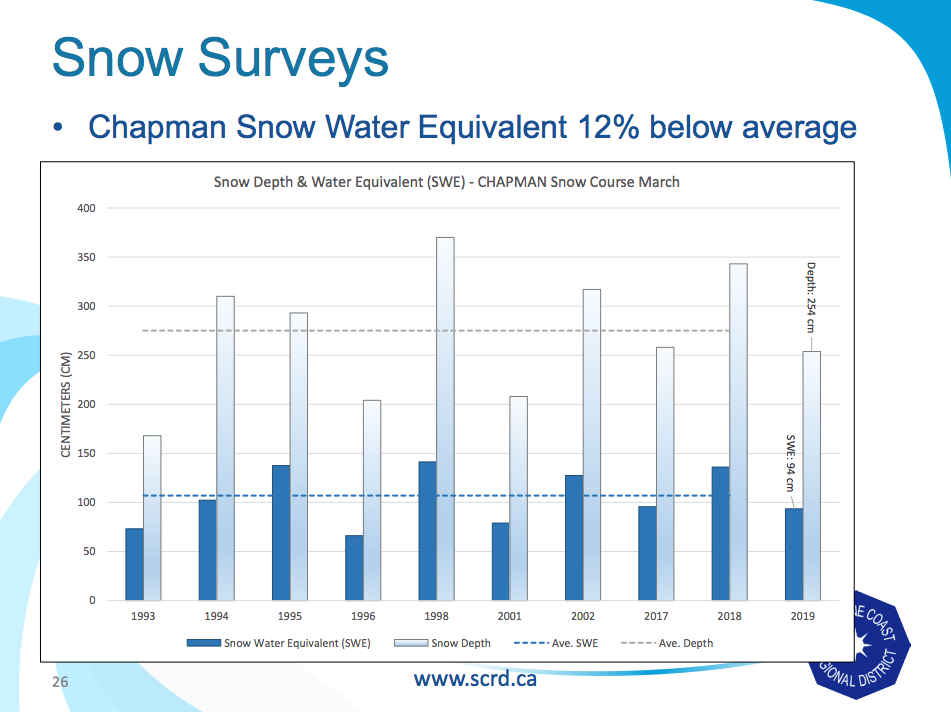Snowpack levels are lower than average at both Chapman and Edwards lakes, similar to conditions in 2015 when severe drought hit the Coast, according to Sunshine Coast Regional District (SCRD) infrastructure services manager Remko Rosenboom.
Water contained in the snowpack at Chapman Lake is 12 per cent below average and 23 per cent below average at Edwards Lake.
Rosenboom noted that in 2015 the “snowpack was well below average.”
“It was an El Niño as well. We’re in a similar situation with low snowpack and a drier than normal spring,” Rosenboom said during the SCRD’s March 21 infrastructure committee meeting.
Even though last year’s spring was warm and dry, an above average snowpack delayed the start of water restrictions.
Halfmoon Bay director Lori Pratt referenced this year’s lower than normal accumulation when defending her position – similar to those expressed by other directors – that the SCRD’s drought management plan should change.
“We need to tighten up on these restrictions when it comes to non-agriculture uses,” said Pratt. “This year the amount of snowpack, having it that much below average, that’s alarming.”
A staff report reviewing the drought plan noted that despite “a culture of conservation” taking root in the community, “residents are adhering less to the watering restrictions.” The report recommended keeping the plan the same.
Directors rejected that sameness and instead pushed for stricter rules, more enforcement and higher fines, but with more flexibility for those who grow food.
Sechelt Mayor Darnelda Siegers said the SCRD is “being overly generous” compared to other municipalities and that fines for infractions are three to five times lower than in other areas.
Last year’s drought management plan reduced demand by about 12 per cent from a modelled baseline, still short of the reduction targets. If they had been met, then Stage 4 wouldn’t have been called and the siphon system wouldn’t have been used, according to a staff report.
While Area F director Mark Hiltz referred to the lack of compliance as “drought fatigue,” Area A director Leonard Lee questioned whether it was worth addressing compliance at all, noting that “the downward spiral” of water supply continued after Stage 2 was called. “I wonder why, or are you just wasting your breath going into these things?” he asked.
Siegers defended her call for stricter enforcement. “I had many people come up to me and say they wanted to see leadership at this table and until they actually saw that we were taking it seriously here, they weren’t going to take the stages seriously,” she said, adding, “I think we’ll see more compliance this year.”
Directors also asked about fines for non-compliance. In 2018, the SCRD issued more written warnings than since 2012, but the number of fines issued has hovered between none and two.
Staff noted one reason the fines are low is because they legally have to stick to public roads, making it difficult to enforce infractions on private property shielded from roadways. In Sechelt, that’s not the case, said Siegers, who asked for more information about why SCRD staff doesn’t get the same leeway.
She also pushed for staff to look at the disparity in fines between the regional district and other areas in B.C.
“I noticed ours are really minimal,” she said. “If they are continually flouting the bylaw, then I think we need to look at whether what we have in here is sufficient of a deterrent.”
Following the discussion, Siegers made a motion for staff to look at how other communities impose water restrictions and fines and to look to further restrict water usage starting at Stage 1. It passed unanimously. She also suggested that the Agricultural Advisory Committee provide input on how water restrictions affect food growers.
Hiltz made a motion for staff to give directors a summary of how public engagement will look this year with regards to water use, which also passed unanimously. “The public education part is going to be crucial,” said Elphinstone director Donna McMahon.
Staff reported that the mandated environmental flow rate of 200 litres per second was maintained throughout the summer in the Chapman system.
At the same meeting, directors voted in support of the Town of Gibsons’ proposal to initiate discussions around a water governance model for the Sunshine Coast.



